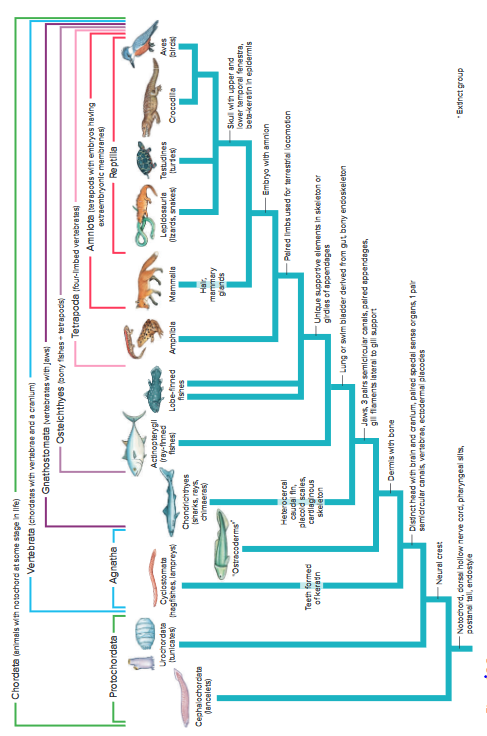Chordata (animals with notochord at some stage in life) Vertebrata (chordates with vertebrae and a cranlum) Gnathostomata vertebrates with Jaws Osteichthyes (aony fishes - tetrapods) Tetrapoda (four-limbed vertebrates) Amnlota tetrepods with embryos having extraembryonic membranes) Re ptilla Agnatha - Protochordata Actinopterygl (ray-fnned Urochordata (tunicates) thegfishes, lampreys) Lepidosauria Testudines (izards, snakes Cyclostomata Mammella Sany (turdes) (sausu pauuy-ag01 fishes eIIpos00 Cephalochordata Jancelets) Chondrichthyes (sharks, rays, chimaeras) mammary glends lul with upper and lower temporal fenestra, beta-keratn in epldermis "Ostracoderms" Embryo with amnion Heterocercal -Pelred limbs used for terrestrial locomotion plecold scales, 'uu iepreo Teeth formed Unique supportve elements in skeleton or girdies of appendages ofkeradn snoubejAJe) skeleton Lung or swim bladder dertved from gut bony endoskeleton Jaws, 3 palrs semiciraular canals, pelred appendages, gill flaments lateral to gl support Dermis with bone Distinct head with brain and crenium, paired specdal sense organs, 1 pair semidrcular canais, vertebrae, ectodermal placodes Neurel crest Exdnct group Notochord, dorsal hollow nerve cord, pheryngeal silits, postanal tall, endostyle
Chordata (animals with notochord at some stage in life) Vertebrata (chordates with vertebrae and a cranlum) Gnathostomata vertebrates with Jaws Osteichthyes (aony fishes - tetrapods) Tetrapoda (four-limbed vertebrates) Amnlota tetrepods with embryos having extraembryonic membranes) Re ptilla Agnatha - Protochordata Actinopterygl (ray-fnned Urochordata (tunicates) thegfishes, lampreys) Lepidosauria Testudines (izards, snakes Cyclostomata Mammella Sany (turdes) (sausu pauuy-ag01 fishes eIIpos00 Cephalochordata Jancelets) Chondrichthyes (sharks, rays, chimaeras) mammary glends lul with upper and lower temporal fenestra, beta-keratn in epldermis "Ostracoderms" Embryo with amnion Heterocercal -Pelred limbs used for terrestrial locomotion plecold scales, 'uu iepreo Teeth formed Unique supportve elements in skeleton or girdies of appendages ofkeradn snoubejAJe) skeleton Lung or swim bladder dertved from gut bony endoskeleton Jaws, 3 palrs semiciraular canals, pelred appendages, gill flaments lateral to gl support Dermis with bone Distinct head with brain and crenium, paired specdal sense organs, 1 pair semidrcular canais, vertebrae, ectodermal placodes Neurel crest Exdnct group Notochord, dorsal hollow nerve cord, pheryngeal silits, postanal tall, endostyle
Chapter24: Animals Ii: The Chordates
Section: Chapter Questions
Problem 12SA: Match the organisms with the appropriate description. ___ tunicates a. pouched mammals ___ fishes b....
Related questions
Question
Explain how a cladistic classification for the vertebrates produces important regroupings of the traditional vertebrate taxa (refer to Figure 23.2). Why are Agnatha and Reptilia, as traditionally recognized, inconsistent with cladistic principles?

Transcribed Image Text:Chordata (animals with notochord at some stage in life)
Vertebrata (chordates with vertebrae and a cranlum)
Gnathostomata vertebrates with Jaws
Osteichthyes (aony fishes - tetrapods)
Tetrapoda (four-limbed vertebrates)
Amnlota tetrepods with embryos having
extraembryonic membranes)
Re ptilla
Agnatha -
Protochordata
Actinopterygl
(ray-fnned
Urochordata
(tunicates) thegfishes, lampreys)
Lepidosauria Testudines
(izards, snakes
Cyclostomata
Mammella
Sany
(turdes)
(sausu
pauuy-ag01
fishes
eIIpos00
Cephalochordata
Jancelets)
Chondrichthyes
(sharks, rays,
chimaeras)
mammary
glends
lul with upper and
lower temporal fenestra,
beta-keratn in epldermis
"Ostracoderms"
Embryo with amnion
Heterocercal
-Pelred limbs used for terrestrial locomotion
plecold scales,
'uu iepreo
Teeth formed
Unique supportve elements in skeleton or
girdies of appendages
ofkeradn
snoubejAJe)
skeleton
Lung or swim bladder dertved from gut bony endoskeleton
Jaws, 3 palrs semiciraular canals, pelred appendages,
gill flaments lateral to gl support
Dermis with bone
Distinct head with brain and crenium, paired specdal sense organs, 1 pair
semidrcular canais, vertebrae, ectodermal placodes
Neurel crest
Exdnct group
Notochord, dorsal hollow nerve cord, pheryngeal silits,
postanal tall, endostyle
Expert Solution
This question has been solved!
Explore an expertly crafted, step-by-step solution for a thorough understanding of key concepts.
This is a popular solution!
Trending now
This is a popular solution!
Step by step
Solved in 2 steps

Knowledge Booster
Learn more about
Need a deep-dive on the concept behind this application? Look no further. Learn more about this topic, biology and related others by exploring similar questions and additional content below.Recommended textbooks for you


Concepts of Biology
Biology
ISBN:
9781938168116
Author:
Samantha Fowler, Rebecca Roush, James Wise
Publisher:
OpenStax College

Biology 2e
Biology
ISBN:
9781947172517
Author:
Matthew Douglas, Jung Choi, Mary Ann Clark
Publisher:
OpenStax


Concepts of Biology
Biology
ISBN:
9781938168116
Author:
Samantha Fowler, Rebecca Roush, James Wise
Publisher:
OpenStax College

Biology 2e
Biology
ISBN:
9781947172517
Author:
Matthew Douglas, Jung Choi, Mary Ann Clark
Publisher:
OpenStax

Biology Today and Tomorrow without Physiology (Mi…
Biology
ISBN:
9781305117396
Author:
Cecie Starr, Christine Evers, Lisa Starr
Publisher:
Cengage Learning

Biology: The Unity and Diversity of Life (MindTap…
Biology
ISBN:
9781305073951
Author:
Cecie Starr, Ralph Taggart, Christine Evers, Lisa Starr
Publisher:
Cengage Learning